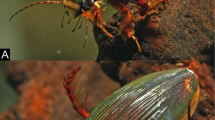Abstract
For conservation purposes, and to supply critically endangered insects for laboratory use, a system for artificial breeding is crucial. However, in the case of carnivorous insects such as diving beetles, the larvae must be isolated because they are cannibalistic. We developed a method for mass breeding the larvae of two diving beetles, Dytiscus sharpi sharpi (Wehncke) and Dytiscus sharpi validus (Régimbart) (Coleoptera: Dytiscidae), which are designated critically endangered species in Japan. Ten to twenty larvae were raised in a small tank (35 cm × 25 cm × 10 cm; water depth 7 cm) with Rana ornativentris (Werner) tadpoles as prey. At low prey density, ~80 % of the larvae were cannibalized. At moderate prey density, 50–60 % were cannibalized. However, at high prey density, <3 % were cannibalized. Well-fed mass-bred adults were larger than individually bred and field-collected adults. This mass breeding method can be used for the conservation and breeding of these rare diving beetles in a manageable number of aquaria.

Similar content being viewed by others
References
Allan JD, Flecker AS (1993) Biodiversity conservation in running waters. Bioscience 43:32–43
Balduf WV (1935) The bionomics of entomophagous Coleoptera. E.W. Classey, Hampton, p 200
Blunck H (1923) Die Entwicklung des Dytiscus marginalis L. vom Ei bis zur Imago. 2. Teil. Die Metamorphose (B. Das Larven–und das Puppenleben). Z Wiss Zool 121:117–391
Brodie ED, Formanowicz DR (1983) Prey size preference of predators: differential vulnerability of larval anurans. Herpetologica 39:67–75
Chiba Prefecture (2000) Red data book of Chiba prefecture. Chiba Prefectural Government, Chiba City (in Japanese)
Chiba Prefecture (2011) Red data book of Chiba prefecture. Chiba Prefectural Government, Chiba City (in Japanese)
Inoda T (2003) Mating and reproduction of predaceous diving beetles, Dytiscus sharpi, observed under artificial breeding conditions. Zool Sci 20:377–382
Inoda T (2011a) Preference of oviposition plant and hatchability of the diving beetle, Dytiscus sharpi (Coleoptera: Dytiscidae) in the laboratory. Entomol Sci 14:13–19
Inoda T (2011b) Cracks or holes in the stems of oviposition plants provide the only exit for hatched larvae of diving beetles of the genera Dytiscus and Cybister. Entomol Exp Appl 140:127–133
Inoda T (2012) Predaceous diving beetle, Dytiscus sharpi sharpi (Coleoptera: Dytiscidae) larva can avoid cannibalism by recognizing its prey. Zool Sci 29:547–552
Inoda T, Kamimura S (2004) New open aquarium system to breed larvae of water beetles (Coleoptera: Dytiscidae). Coleop Bull 58:37–43
Inoda T, Tsuzuki Y (1999) Breeding methods of Dytiscus sharpi validus Régimbart, 1899. Gekkan Mushi 336:25–30 (in Japanese with English summary)
Inoda T, Tajima F, Taniguchi H, Saeki M, Numakura K, Hasegawa M, Kamimura S (2007) Temperature-dependent regulation of reproduction in the diving beetle Dytiscus sharpi (Coleoptera: Dytiscidae). Zool Sci 24:1115–1121
Inoda T, Hasegawa M, Kamimura S, Hori M (2009) Dietary program for rearing the larvae of a diving beetle, Dytiscus sharpi (Wehncke), in the laboratory (Coleoptera: Dytiscidae). Coleopt Bull 63:340–350
Jeffries M (1988) Individual vulnerability to predation: the effect of alternative prey types. Freshw Biol 19:49–56
Johansson A, Nilsson AN (1992) Dytiscus latissimus and D. circumcinctus (Coleoptera, Dytiscidae) larvae as predators on three case—making caddis larvae. Hydrobiologia 248:201–213
Kamite Y, Hikida N, Satô M (2003) New record of Hydroglyphus flammulatus (Sharp) from Japan. Coleopterists News 142:15–17 (in Japanese)
Kamite Y, Hikida N, Satô M (2005) Notes on the Laccophilus kobensis species-group (Coleoptera, Dytiscidae) in Japan. Elytra 33(2):617–628
Ministry of the Environment, Government of Japan (2011) National endangered species of wild fauna and flora of Japan. Ministry of the Environment, Tokyo (in Japanese)
Ministry of the Environment, Government of Japan (2012) Red list of Japan (in Japanese). Ministry of the Environment, Tokyo
Mori M, Kitayama A (2002) Dytiscoidea of Japan, revised edn. Bun-ichi Sogo Shuppan, Tokyo (in Japanese)
Ohba S (2009) Feeding habits of the diving beetle larvae, Cybister brevis Aubé (Coleoptera: Dytiscidae) in Japanese wetlands. Appl Entomol Zool 44(3):447–453
Okada Y (2011) A new species of the genus Platambus (Coleptera, Dytiscidae) from Hokkaido, Japan. Elytra (New Series) 1:31–38
R Development Core Team (2012) R: a language and environment for statistical computing. R Foundation for Statistical Computing, Vienna. http://www.R-project.org/. Accessed 26 April 2012
Wesenberg-Lund C (1943) Biologie der Susswasserinsekten. Nordisk forlag, Copenhagen, p 682
Yamaguchi H (1992) Dytiscus sharpi. (2) Observation and breeding. Ettcy 23:6–24 (in Japanese)
Young AL (1967) Predation in the larvae of Dytiscus marginalis Linnaeus (Coleoptera: Dytiscidae). Pan-Pac Entomol 43:113–117
Acknowledgments
We thank Mr. Linton Teoh (Sydney, Australia) and Mr. R. Z. Corpuz (University of the Philippines) for their English review. We would like to extend our appreciation to two anonymous reviewers for their constructive comments on the manuscript.
Author information
Authors and Affiliations
Corresponding author
Rights and permissions
About this article
Cite this article
Inoda, T., Kitano, T. Mass breeding larvae of the critically endangered diving beetles Dytiscus sharpi sharpi and Dytiscus sharpi validus (Coleoptera: Dytiscidae). Appl Entomol Zool 48, 397–401 (2013). https://doi.org/10.1007/s13355-013-0176-4
Received:
Accepted:
Published:
Issue Date:
DOI: https://doi.org/10.1007/s13355-013-0176-4




